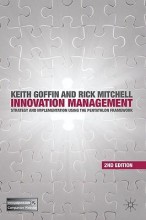Summary: Capabilities For Managing Service Innovation: Towards A Conceptual Framework
- This + 400k other summaries
- A unique study and practice tool
- Never study anything twice again
- Get the grades you hope for
- 100% sure, 100% understanding
Read the summary and the most important questions on Capabilities for managing service innovation: towards a conceptual framework
-
2 Service innovation as a multidimensional phenomenon
This is a preview. There are 8 more flashcards available for chapter 2
Show more cards here -
What is service innovation?
"A service innovation is a new service experience or service solution that consists of one or several of the following dimensions: new service concept, new customer interaction, new value system/business partners, new revenue model, new organizational or technological delivery system." -
What are the six dimensions?
- The Service Concept or service offering.
- The New Customer Interaction
- The New Business Partner or new value system
- New revenue models
- New delivery system: personnel, organization and culture.
- New delivery system: technological.
- The Service Concept or service offering.
-
What does the service concept or service offering describe?
The value that is created by the service provider in collaboration with the customer. The innovation is often a new idea of how to organize a solution to a problem or a need of a customer. -
What is meant with the new customer interaction?
The role the customer plays in the creation of value, an important source of innovations sometimes more important than the offering itself to support innovation. The majority of innovations here are variations on the introduction of “self service”. -
What is meant with new revenue models?
New services, especially those produced by multiple actors, need new models to distribute costs and revenues in appropriate ways. Many new service ideas fail as the distribution of costs and revenues do not match à developing the right revenue model to fit a new service concept may require considerable ingenuity. -
What does the new delivery system: technology pinpoint?
The observation that ICTs (predominantly, but not exclusively) have enabled numerous service innovations ranging from electronic government and e-health, to advanced multi-channel management, customization of services, introduction of self service concepts, virtual project teams and so on. -
What is the ultimate goal of service innovation of the 6D model?
To provide a solution or an experience. -
Where can a new service solution or new service experience consist of?
Of a new service, a new service portfolio and/or a new service process that individually or in combination defines a new way of creating value for the customer. -
3 Six dynamic capabilities for managing service innovation
This is a preview. There are 3 more flashcards available for chapter 3
Show more cards here -
3.1 Defining dynamic service innovation capabilities - introducing the RBV and DCV
This is a preview. There are 8 more flashcards available for chapter 3.1
Show more cards here -
How is in the RBV a resource defined?
As "an asset or input to production that an organization owns, controls or has access to on a semi-permanent basis". -
How does the RBV conceptualize firms?
As 'bundles of resources' that are 'heterogeneously distributed across firms' and assumes that these 'resources differences persist over time'.
- Higher grades + faster learning
- Never study anything twice
- 100% sure, 100% understanding
Topics related to Summary: Capabilities For Managing Service Innovation: Towards A Conceptual Framework
-
Six dynamic capabilities for managing service innovation - Defining dynamic service innovation capabilities - introducing the RBV and DCV
-
Six dynamic capabilities for managing service innovation - Defining dynamic service innovation capabilities
-
Six dynamic service innovation capabilities - Signaling user needs and technological options
-
Six dynamic service innovation capabilities - Conceptualizing



























